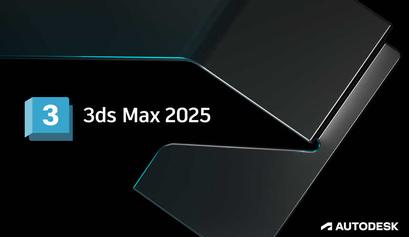
Autodesk has begun rolling out 3ds Max 2025. While there hasn’t been an official announcement, many users are reporting the ability to download the new version from their Autodesk Accounts. Comprehensive documentation is already available online.
3ds Max 2025 incorporates OpenColorIO as the default color management system for new projects. The VertexPaint tool has been integrated into this color-managed workflow, allowing precise color adjustments directly on models. A new Color Space Conversion operator for Data Channel modifiers enables color data conversion across different rendering spaces, improving flexibility in post-processing.
The update also enhances the Global Search feature, revamped to provide an expanded list of commands, tools, and settings to streamline the search process. This makes finding and executing commands faster and more efficient. The search feature remembers the last five used items, offering quick access to frequently used functions, and introduces a category display for better organization. A dockable search window and customizable search bar aim to improve the user interface.
Improvements have been made to the Retopology Tools with the integration of preprocessing and OpenVDB remeshing as standalone processes. These tools are crucial for optimizing 3D models, reducing complexity while maintaining fidelity. The update to the Autodesk ReForm algorithm enhances performance and stability, promising up to 8% faster processing times.
A newly introduced Menu Editor improves customization, enabling users to easily adjust menus and quad menus. This feature supports the creation, renaming, and reorganization of menu items. A Developer Mode within the Menu Editor provides additional functionality for integrating third-party plugins, further expanding 3ds Max’s versatility.
The integration of the updated Universal Scene Description (USD) plug-in in 3ds Max 2025 includes improved import capabilities for camera and light animations and blendShapes. Users can now select and move USD primitives directly in the viewport and more.
Arnold for 3ds Max 5.7.0.0 introduces a significant overhaul of the GPU renderer, global light sampling in volumes, and the introduction of dithered samples in progressive and adaptive rendering. These updates aim to reduce rendering times, improve render quality, and enhance the overall efficiency of the rendering process, particularly for handling complex scenes and high-resolution outputs.
Among the other notable improvements, there are changes to the Character Animation Toolkit, enhancing animation workflows and addressing long-standing user feedback. These improvements include stability fixes related to CAT object deletion, working with Wire Parameters, and using CAT bone twist weights. Enhancements have also been made to the copy/paste functionality of CAT layers, particularly in Extraction mode, improving usability in complex animation projects. Issues related to viewport refresh, scene loading due to loop references, and handling of empty animation layers have also been addressed, significantly boosting the software’s reliability and performance in animation tasks.
Furthermore, an Assign Controller arrow navigation fix has been introduced, correcting a crash that could occur when using arrow keys to navigate the Controller list. This fix makes the interface more intuitive and less prone to errors. The List Controller has also seen adjustments to its scaling.
Another user-requested feature, the Save Incremental option, has been added to the File menu, allowing users to save incremental copies of their scenes for better project management.
The release brings updates to the OpenSubdiv modifier, upgrading it to version 3.6, which provides faster results and ensures compliance with the VFX Reference Standard. The Mesh Cleaner modifier has also been updated, introducing new options for tasks such as addressing zero area UV, non-planar faces, and isolated vertices.
Additionally, improvements to viewport shadows have been added, with the default size limit for shadow maps increased from 512 to 4096. Finally, the Slate Material Editor now lets users quickly open a View Image File window by right-clicking on a Bitmap node.
This article will be updated as more information and demo videos become available.
